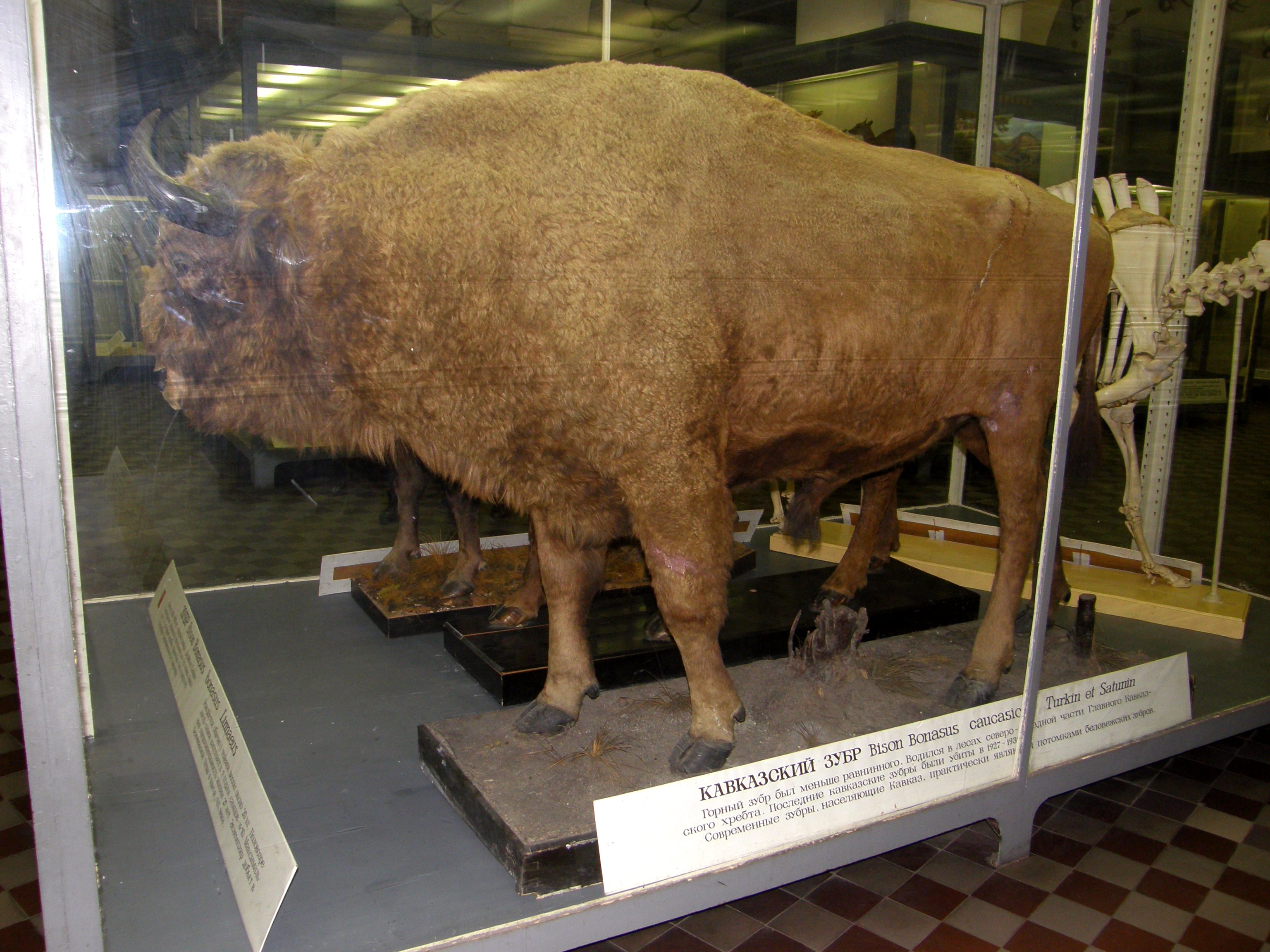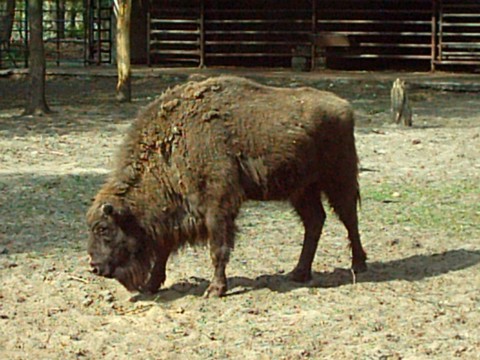Caucasian wisent on:
[Wikipedia]
[Google]
[Amazon]
The Caucasian wisent (''Bison bonasus caucasicus'') or dombay (''домбай'') was a subspecies of
 Little is known about morphological details of this subspecies including body size due to extinction before modern scientific approaches were made.
Comparared to the extant lowland wisent, the Caucasian bison was more adapted to mountainous habitat.Semenov U.A. of WWF-Russia, 2014, "The Wisents of Karachay-Cherkessia", Proceedings of the
Little is known about morphological details of this subspecies including body size due to extinction before modern scientific approaches were made.
Comparared to the extant lowland wisent, the Caucasian bison was more adapted to mountainous habitat.Semenov U.A. of WWF-Russia, 2014, "The Wisents of Karachay-Cherkessia", Proceedings of the
 In the 17th century, the Caucasian bison still populated a large area of the
In the 17th century, the Caucasian bison still populated a large area of the
 Only one Caucasian bison bull is known to have been kept in captivity. This bull, named Kaukasus, was born in the Caucasus Mountains in 1907 and brought to Germany in 1908 where he lived until 26 February 1925. While in captivity, he bred with cows from the lowland subspecies ''Bison bonasus bonasus''. Thus, he became one of the twelve ancestors of the present lowland-Caucasian breeding line of the European wisent pedigree book.
Only one Caucasian bison bull is known to have been kept in captivity. This bull, named Kaukasus, was born in the Caucasus Mountains in 1907 and brought to Germany in 1908 where he lived until 26 February 1925. While in captivity, he bred with cows from the lowland subspecies ''Bison bonasus bonasus''. Thus, he became one of the twelve ancestors of the present lowland-Caucasian breeding line of the European wisent pedigree book.
The Extinction Website - Caucasian European Bison - Bison bonasus caucasicus
History of the Caucasian European Bison
(In Russian) {{Taxonbar, from=Q2528872 Bison Mammal extinctions since 1500 Extinct mammals of Europe Species made extinct by human activities
European bison
The European bison (''Bison bonasus'') or the European wood bison, also known as the wisent ( or ), the zubr (), or sometimes colloquially as the European buffalo, is a European species of bison. It is one of two extant species of bison, along ...
that inhabited the Caucasus Mountains
The Caucasus Mountains,
: pronounced
* hy, Կովկասյան լեռներ,
: pronounced
* az, Qafqaz dağları, pronounced
* rus, Кавка́зские го́ры, Kavkázskiye góry, kɐfˈkasːkʲɪje ˈɡorɨ
* tr, Kafkas Dağla ...
of Eastern Europe
Eastern Europe is a subregion of the Europe, European continent. As a largely ambiguous term, it has a wide range of geopolitical, geographical, ethnic, cultural, and socio-economic connotations. The vast majority of the region is covered by Russ ...
.
Description
 Little is known about morphological details of this subspecies including body size due to extinction before modern scientific approaches were made.
Comparared to the extant lowland wisent, the Caucasian bison was more adapted to mountainous habitat.Semenov U.A. of WWF-Russia, 2014, "The Wisents of Karachay-Cherkessia", Proceedings of the
Little is known about morphological details of this subspecies including body size due to extinction before modern scientific approaches were made.
Comparared to the extant lowland wisent, the Caucasian bison was more adapted to mountainous habitat.Semenov U.A. of WWF-Russia, 2014, "The Wisents of Karachay-Cherkessia", Proceedings of the Sochi National Park
Sochi National Park (russian: Сочинский национальный парк, also Sochinsky National Park) is Russia's oldest national park, established on May 5, 1983. It is located in the Western Caucasus, near the city of Sochi, in South ...
(8), pp.23–24, , KMK Scientific Press Apparently, Caucasian bison was generally smaller (there had been arguments regarding the Caucasian bison to be smaller than the lowland bison, but most certainly less weighed), had shorter but higher hooves, had more developed shoulder girdle
The shoulder girdle or pectoral girdle is the set of bones in the appendicular skeleton which connects to the arm on each side. In humans it consists of the clavicle and scapula; in those species with three bones in the shoulder, it consists of ...
s, had skulls similar in size to those found in Kuban
Kuban (Russian language, Russian and Ukrainian language, Ukrainian: Кубань; ady, Пшызэ) is a historical and geographical region of Southern Russia surrounding the Kuban River, on the Black Sea between the Pontic–Caspian steppe, ...
region, had significantly thicker and larger horns, less shaggy coats, and curly hairs on head rear.Daniel Foidl, 2013, Over-purity as a danger for the Wisent?, The Breeding-back blog, Tauros Programme
The Tauros Programme, formerly known as TaurOs Project, is a cooperation between the Dutch foundation Stichting Taurus and universities such as the Wageningen University and Research Centre. It is an international effort to breed a type of ca ...
Natural enemies
It was hunted by theCaspian tiger
The Caspian tiger was a ''Panthera tigris tigris'' population native to eastern Turkey, northern Iran, Mesopotamia, the Caucasus around the Caspian Sea, Central Asia to northern Afghanistan, and the Xinjiang region in western China. Until the Midd ...
and the Asiatic lion
The Asiatic lion is a population of ''Panthera leo leo'' that today survives in the wild only in India. Since the turn of the 20th century, its range has been restricted to Gir National Park and the surrounding areas in the Indian state of Gujarat ...
in the Caucasus
The Caucasus () or Caucasia (), is a region between the Black Sea and the Caspian Sea, mainly comprising Armenia, Azerbaijan, Georgia, and parts of Southern Russia. The Caucasus Mountains, including the Greater Caucasus range, have historically ...
, as well as other predators such as wolves
The wolf (''Canis lupus''; plural, : wolves), also known as the gray wolf or grey wolf, is a large Canis, canine native to Eurasia and North America. More than thirty subspecies of Canis lupus, subspecies of ''Canis lupus'' have been reco ...
and bear
Bears are carnivoran mammals of the family Ursidae. They are classified as caniforms, or doglike carnivorans. Although only eight species of bears are extant, they are widespread, appearing in a wide variety of habitats throughout the Nor ...
s.
Decline and extinction
 In the 17th century, the Caucasian bison still populated a large area of the
In the 17th century, the Caucasian bison still populated a large area of the Western Caucasus
The Western Caucasus is a western region of the Caucasus in Southern Russia, extending from the Black Sea to Mount Elbrus.
World Heritage Site
The Western Caucasus includes a natural UNESCO World Heritage Site comprising the extreme western e ...
. After that human settlement in the mountains intensified and the range of the Caucasian wisent became reduced to about one tenth of its original range at the end of the 19th century. In the 1860s the population still numbered about 2,000, but was reduced to only 500-600 in 1917 and to only 50 in 1921.. Presented in Russian originally; translated into English in 1990, but never published in that form Local poaching continued; finally, in 1927, the last three Caucasian wisent were killed. n Russian./ref>
Hybrid survivors
 Only one Caucasian bison bull is known to have been kept in captivity. This bull, named Kaukasus, was born in the Caucasus Mountains in 1907 and brought to Germany in 1908 where he lived until 26 February 1925. While in captivity, he bred with cows from the lowland subspecies ''Bison bonasus bonasus''. Thus, he became one of the twelve ancestors of the present lowland-Caucasian breeding line of the European wisent pedigree book.
Only one Caucasian bison bull is known to have been kept in captivity. This bull, named Kaukasus, was born in the Caucasus Mountains in 1907 and brought to Germany in 1908 where he lived until 26 February 1925. While in captivity, he bred with cows from the lowland subspecies ''Bison bonasus bonasus''. Thus, he became one of the twelve ancestors of the present lowland-Caucasian breeding line of the European wisent pedigree book.
Wisent reintroductions in the Caucasus
In 1940, a group of wisent-American bison
The American bison (''Bison bison'') is a species of bison native to North America. Sometimes colloquially referred to as American buffalo or simply buffalo (a different clade of bovine), it is one of two extant species of bison, alongside the ...
hybrids were released into the Caucasian
Biosphere Reserve and later in 1959 in the Nalchik Forestry Game Management Unit (Kabardino-Balkariya). Later some pure-blood wisent of the lowland-Caucasian breeding line were released there to form a single mixed herd together with the hybrids.
In 2000, these hybrids were described as a different (without scientific basis) subspecies, the highland bison - ''Bison bonasus montanus'' (Polish
Polish may refer to:
* Anything from or related to Poland, a country in Europe
* Polish language
* Poles
Poles,, ; singular masculine: ''Polak'', singular feminine: ''Polka'' or Polish people, are a West Slavic nation and ethnic group, w ...
).
See also
*List of extinct animals of Europe
This list of European animals extinct in the Holocene features animals known to have become extinct in the last 12,000 years on the European continent and its surrounding islands.
Dependent territories of European countries in other continents, l ...
*Carpathian wisent
The Carpathian wisent (''Bison bonasus hungarorum'') was a subspecies of the European bison that inhabited the Carpathian Mountains, Moldavia and Transylvania. It may also have lived in what are today Ukraine and Hungary.
It began to die out about ...
*Caucasian moose
The Caucasian moose, also known as the Caucasian elk (''Alces alces caucasicus'') is an extinct subspecies of moose found in the Caucasus Mountains of Eastern Europe and Asia Minor, in modern-day European Russia, Armenia, Azerbaijan, Georgia, ...
References
External links
The Extinction Website - Caucasian European Bison - Bison bonasus caucasicus
(In Russian) {{Taxonbar, from=Q2528872 Bison Mammal extinctions since 1500 Extinct mammals of Europe Species made extinct by human activities